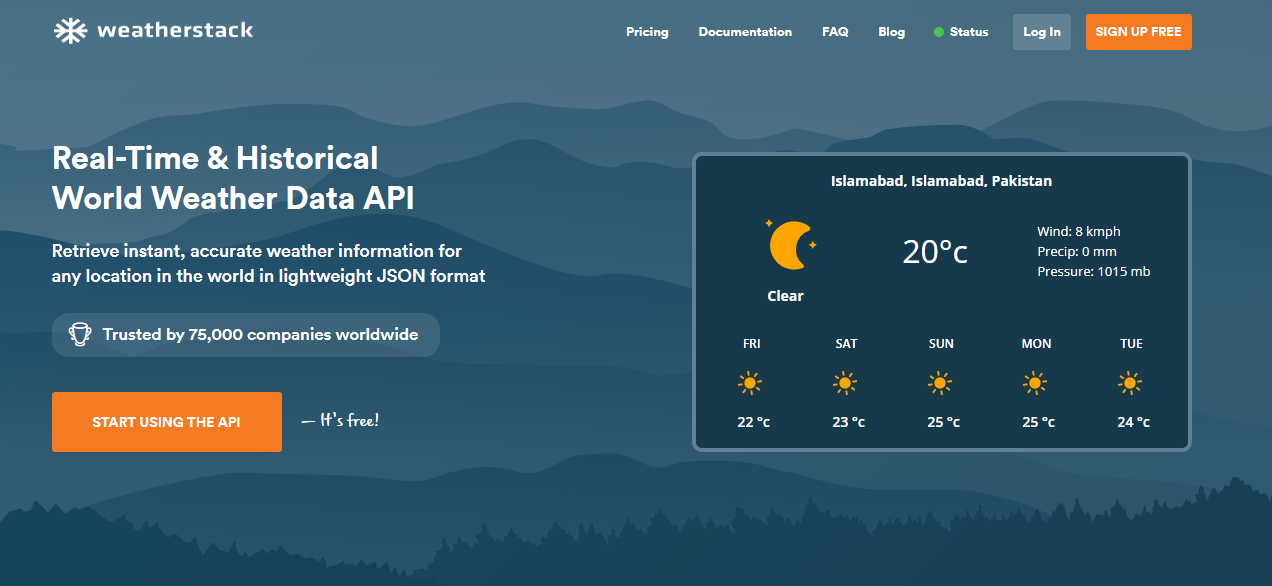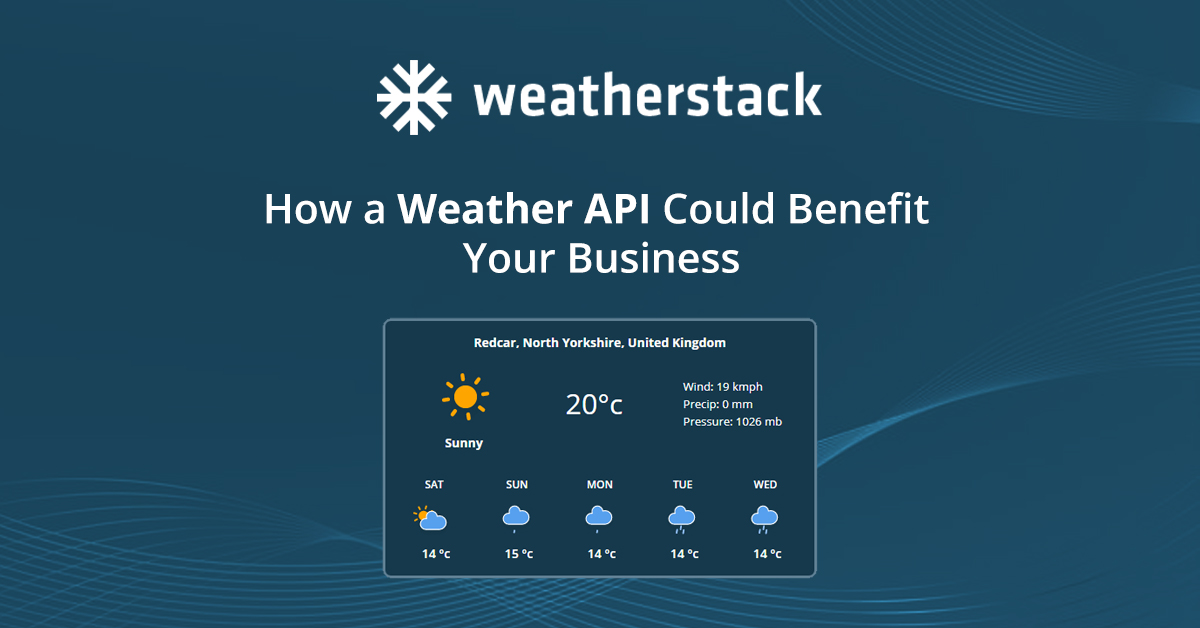Weather exerts a broader influence on our lives than we realize, and it’s no different for businesses. Anticipating precise forecasts for rain, snow, or sunshine in your region empowers businesses to make informed decisions. But how should one get this real-time weather data insight? It is where free APIs like Weatherstack, weather information API come in and act as your weather assistant. The open weather API provides real-time weather information that is sent straight to your business applications.
In this blog, we will explore the exciting world of Weatherstack API and understand how it can bring sunshine to your business strategies. So, grab your virtual raincoat, and let’s dive into how a free Weather API could be a game-changer for your business.

Table of Contents
What Is a Weather API?
A Weather API is like a digital tool that helps apps and websites grab current weather information automatically. It’s like a bridge between them and a big database of weather data. This data includes temperature, humidity, and forecasts, which can make apps more helpful and keep us informed about the weather.
Choosing Your Weather Forecast API: Essential Considerations
Selecting the optimal Weather Forecast API requires a comprehensive evaluation of various factors. Take a look at some of them:
- Accuracy and Reliability: You should prefer an API that uses advanced forecasting models and reliable data sources to provide accurate weather forecasts of your location or region of interest.
- Large Feature Set: Your desired API should be capable of providing historical data, short-term hourly forecasts, and extended forecasts. Moreover, it should also provide a range of weather parameters such as UV index, humidity, precipitation, wind speed, and temperature.
- Data Format Compatible with Your Apps: You should evaluate the data format provided by the API and whether it is JSON, XML, or CSV. These data formats are suitable for various programming languages, platforms, and applications.
- Update Frequency and Timeliness: You should pick an API that provides frequent updates so that you remain up-to-date with the latest weather data.
- Scalability: The API should easily scale to meet increased data usage as your application grows without significant performance degradation.
- Pricing Structure: Choose an API that offers tiered pricing plans so that you can choose a plan aligned with your requirements. Moreover, it will allow you to upgrade the plans to meet growing application needs.
- Ease of Integration: Select a plan that integrates easily with the existing applications. Moreover, you should consider an API that is user-friendly for developers and provide code examples for seamless integration.
Weatherstack – Weather API
Weatherstack is a helpful tool made by ApiLayer, a company that creates popular tools for developers. They’ve made things like ipstack, mailbox layer, and currency layer. Weatherstack lets us get live weather information without spending much money. It can tell us about weather from around the world, past weather, and what’s happening right now. Here’s how it works:
- It’s like a special type of website that gives us weather facts.
- The facts come back in a computer-friendly language called JSON.
- It can also talk to other websites using JSONP.
- If we want to keep our connection secure, payment options are available.
Pricing
- How much we pay depends on the plan we choose.
- We can use it for free or pick a more advanced plan.

What Are the 5 Ways Weatherstack API Can Benefit Your Business?
The Weatherstack API offers five valuable ways to benefit your business. Let’s explore them.
Real-time Weather Data
Firstly, the Weatherstack API delivers real-time weather data. This means you can access up-to-the-minute information about the weather conditions in any location. This data can be immensely useful for various purposes, such as planning outdoor events, adjusting work schedules, or making informed travel decisions. Access to accurate and current weather information helps you stay prepared and make informed choices.
Strategic Decision-Making
Secondly, the API supports strategic decision-making. Businesses can analyze historical weather patterns and current conditions to make smart choices. For example, a retail store might adjust its marketing strategies based on upcoming weather forecasts. If rain is predicted, they could promote indoor products. This data-driven decision-making process allows companies to align their operations with weather trends, enhancing efficiency and profitability.
Enhancing Customer Experience
Thirdly, the Weatherstack API contributes to enhancing customer experience. You can provide personalized recommendations and advice by incorporating weather forecasts into your customer-facing applications or websites. For instance, a travel website could suggest suitable destinations based on the user’s preferred weather conditions. This level of customization creates a positive and engaging experience, increasing customer satisfaction and loyalty.
Supply Chain and Logistics Optimization
Fourthly, the API aids in supply chain and logistics optimization. Businesses that rely on transportation, shipping, or storage can use weather data to plan routes, anticipate delays, and manage inventory effectively. For instance, a delivery company can reroute their vehicles to avoid severe weather conditions, ensuring that goods reach their destinations on time. This optimization minimizes disruptions and maximizes operational efficiency.
Risk Management and Disaster Preparedness
Lastly, the Weatherstack API contributes to risk management and disaster preparedness. Certain industries, such as agriculture and construction, are highly sensitive to weather conditions. By monitoring weather forecasts and historical data, businesses can proactively mitigate risks. Farmers, for instance, can adjust planting and harvesting schedules based on weather predictions, reducing potential crop losses. This preparedness approach helps businesses minimize damages and recover more swiftly from adverse weather events.

How To Implement Weatherstack API?
The Weatherstack API is a tool that helps your program get weather information online. It’s like asking a smart friend about the current weather outside. Here’s how you can use it:
1. Get an API Key
Think of an API key like a secret password you need to use the Weatherstack API. You usually get this from the Weatherstack website when you sign up.

2. Make a Request
Imagine you’re sending a message to the Weatherstack service. You must say what you want, like “Hey, can you tell me the weather?” You send a special message called an “HTTP request” from your program to do this.
3. Receive a Response
After you send your request, Weatherstack will reply with your requested weather information. This response will be in a format your program can understand, like a text message or a data table.
4. Read the Data
Once you have the response, you must read it to find the weather details. The information could include temperature, humidity, wind speed, and more.
5. Use the Data
You can use it in your program now that you know the weather. For example, you could display the current temperature on a website or make decisions based on the weather conditions.
Here’s a simple example in Python code to get the current weather using the Weatherstack API:
import requests
import json
# Replace 'YOUR_API_KEY' with the API key you got from Weatherstack
api_key = 'YOUR_API_KEY'
# The location you want to get the weather for
location = 'New York, United States of America'
# Making the request to Weatherstack API
response = requests.get(f'https://api.weatherstack.com/current?access_key={api_key}&query={location}')
# Checking if the request was successful
if response.status_code == 200:
weather_data = response.json() # Convert the response to a dictionary
response_structure = {
"request": {
"type": "City",
"query": location,
"language": "en",
"unit": "m"
},
"location": {
"name": weather_data['location']['name'],
"country": weather_data['location']['country'],
"region": weather_data['location']['region'],
"lat": weather_data['location']['lat'],
"lon": weather_data['location']['lon'],
"timezone_id": weather_data['location']['timezone_id'],
"localtime": weather_data['location']['localtime'],
"localtime_epoch": weather_data['location']['localtime_epoch'],
"utc_offset": weather_data['location']['utc_offset']
},
"current": {
"observation_time": weather_data['current']['observation_time'],
"temperature": weather_data['current']['temperature'],
"weather_code": weather_data['current']['weather_code'],
"weather_icons": weather_data['current']['weather_icons'],
"weather_descriptions": weather_data['current']['weather_descriptions']
}
}
# Print the structured response with indentation for readability
print(json.dumps(response_structure, indent=4))
else:
print("Oops! Something went wrong.")
```Example Response By Weatherstack
{
"request": {
"type": "City",
"query": "New York, United States of America",
"language": "en",
"unit": "m"
},
"location": {
"name": "New York",
"country": "United States of America",
"region": "New York",
"lat": "40.714",
"lon": "-74.006",
"timezone_id": "America/New_York",
"localtime": "2023-08-24 12:01",
"localtime_epoch": 1692878460,
"utc_offset": "-4.0"
},
"current": {
"observation_time": "04:01 PM",
"temperature": 22,
"weather_code": 122,
"weather_icons": [
"https://cdn.worldweatheronline.com/images/wsymbols01_png_64/wsymbol_0004_black_low_cloud.png"
],
"weather_descriptions": [
"Overcast"
]
}Transform your Business Operations with Real-Time Weather Insights!
You can now streamline your business operations with Weatherstack API. The API features customizable features, reliable support, and interactive documentation, which empowers developers to implement weather data easily into the applications. Moreover, the API enables you to embrace smarter decision-making, enhanced customer engagement, and operational efficiency powered by accurate weather insights. Gain immediate access to API from marketplaces such as APILayer and get precise forecasts of historical weather data to stay updated.
Discover how Weatherstack API can elevate your business to new heights!
Conclusion
Integrating the best Weather API, such as Weatherstack, into your business operations offers substantial advantages. From providing precise weather information to empowering informed decision-making, it enables businesses across various sectors to optimize operations. It also enhances customer satisfaction by enabling tailored services and promotions based on current weather conditions. Therefore, integrating a weather API helps you deliver exceptional experiences that take your business to new heights.
FAQs
Does Weatherstack API support multiple programming languages?
Yes, Weatherstack API supports multiple programming languages such as PHP, Python, Nodejs, jQuery, Go, and Ruby. You can look for the documentation and use the code examples in these languages for integration.
How do I get the Weatherstack Weather API key?
To get the Weatherstack API, create an account on Weatherstack’s official website and log in using your registered email address. Once you login, get the weather API key, gain access the Weatherstack API endpoints to retrieve weather data for your applications, websites, or services.
Does Weatherstack API offer historical weather data?
Yes, Weatherstack API historical data that supports trend analysis, research, and building predictive models.
Do you have to pay for Weatherstack API?
The Weatherstack API offers a free package for 250 Calls/mo with no support. However, you can upgrade to Standard, Professional, Business, or Enterprise plans for premium features.
Is Weatherstack API scalable for businesses of all sizes?
Yes, Weatherstack API is scalable for businesses of all sizes, from startups to SMEs to large enterprises.


